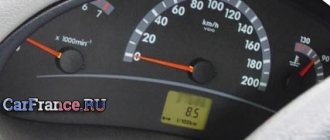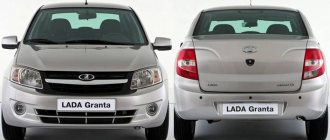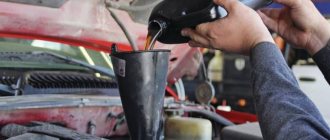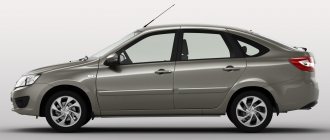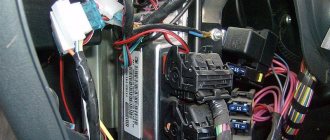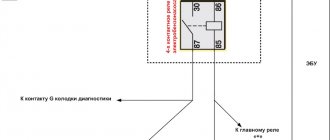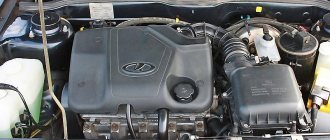The main indicator of economical operation of a car engine is specific fuel consumption. There are several methods for determining it. Every manufacturer wants their cars to have this figure as low as possible. Therefore, the methods for determining gasoline consumption differ from one another. The Russian manufacturer represented by AvtoVAZ claims that the fuel consumption of the Lada Granta averages 6.7-7.7 l/100 km in the combined driving cycle. However, passport data does not always coincide with actual results.
How are fuel consumption standards determined?
Gasoline consumption is determined in laboratory conditions. There are special techniques for this. For example, in Europe, consumption is determined according to NEDC standards - the new European driving cycle. The standard was last updated in 1997. Its disadvantage is that the choice of vehicle and test conditions is at the discretion of the automaker. Instead of a new car, a run-in version of the tested model can be used and almost perfect conditions created for this (windows closed, air conditioning, headlights and MMC turned off, etc.).
To simulate driving in the city and on the highway, different testing times are selected. Special rubber and low viscosity lubricating oil may be used. The presence of these factors leads to the fact that gasoline consumption standards appear in the car's passport, which are far from the true ones. The American and Japanese methods are more stringent, so the documents indicate values that are close to objective. In some cases, if you buy a car with a passport consumption of 7.5 liters per 100 km, in reality it turns out that it consumes 10-12 liters. This figure may increase depending on the season, fuel quality, load, road and engine conditions and many other factors. Therefore, drivers themselves try to determine specific fuel consumption and take measures to reduce it.
Technical reasons for increased fuel consumption
Despite the fact that VAZ has stepped far forward in improving its products, many unresolved problems remain. And some of them have a direct impact on the amount of gasoline consumed.
Injector diagram (fuel supply to combustion chambers)
All influencing factors can be divided into “hardware” and “software”. This classification was the result of the use of an injection engine, as well as the abundance of sensors in the car’s design.
Incorrectly selected fuel
Diagnosis of car electronic systems
In particular, we are talking about
- temperature sensors,
- throttle position sensors,
- as well as mass air flow.
In the latter case, its breakdown may be due to prolonged use. And, of course, incorrect readings can result from false information from the oxygen sensor, which is also simply called a lambda probe.
All this can lead to both the preparation of a “lean” and “rich” mixture. As a result, power may be lost or fuel consumption may increase. A malfunction can be detected by diagnosing each sensor separately.
Fuel system pressure
In Fig. car fuel frame and receiver
This is another common breakdown. The fact is that the pressure level can be too high or low, although the second option is much more common. This can be determined when the engine loses power and you have to drive at higher speeds to maintain the desired dynamics. This all significantly increases fuel consumption.
If you have problems with the fuel rail, then...
Injector problem
If you do not monitor the condition of the power unit, this will lead to shortcomings in its operation. Most often, this concerns contamination of the injectors, followed by poor supply of the working mixture, so you will try to compensate for this by increasing the speed.
Catalyst destruction
Similar results occur when the catalyst burns out or even breaks down. Without going into detail about the specifics of this situation, we can simply conclude that if the catalyst is contaminated, a “rich” mixture will form. After this, additional heating of the catalyst occurs, reducing its service life and reducing engine power.
Motor temperature
In addition to all of the above, it would be a good idea to constantly monitor the engine temperature. If it is above 103 degrees, then the mixture will not be of sufficient quality. The engine will begin to operate on a “lean” mixture, reducing its power and increasing gasoline consumption.
The main drawback is that the instrument panel on the Lada Granta does not have an indication in mode.
If the engine has not yet warmed up, this leads to an increase in consumption due to the “enrichment” of the mixture. The level of overspending reaches 20 percent.
In most cases, the cause must be found in the thermostat.
Incorrect engine operation
Increased fuel consumption may be due to a “broken” engine. That is, the engine is worn out. The main symptoms of engine wear will be:
- There is no compression.
- Maslozhor.
- Other.
- bad dynamics
- erratic engine operation
- incorrectly selected oil ( , )
- insufficient running-in of components on a new car (read the material: “)
Air filter dirty
Old filter
And, of course, we must not forget that if air flows poorly through this filter, the effect of “oxygen starvation” will begin. This will entail a significant excess of gasoline consumption.
How to reduce consumption using “economical firmware”?
Considering that the Lada Granta has an on-board computer and a full set of electronic systems, you can flash this system yourself. That is, you replace the standard settings that were made at the factory with those that you consider necessary.
Of course, this can be considered a dangerous procedure, but it is worth remembering that the manufacturer may not have counted on the conditions under which a particular machine is operated. So, with such simple manipulations, fuel consumption can be reduced by up to 20 percent.
If the result does not suit you, you can always return the original firmware.
The only advice would be not to perform these procedures if you have a valid car warranty. In addition, only professionals should do this. If you do this yourself, then you need to first study this topic in detail.
The simplest advice would be to switch the car to consume natural gas.
Of course, the fuel itself will not be consumed less, but the price of one kilometer of travel will be reduced by up to two times. Problems arise only in terms of too rapid wear of some parts.
So, for infrequent trips, there will be practically no benefit from such a procedure.
You can also give up comfort while driving.
We're talking about turning off all electrical appliances, from the radio to the air conditioner. This will save from half to one liter of gasoline for every hundred kilometers driven.
There is an opinion that you can save money when coasting downhill.
This is indeed true. But you also need to remember that control over the car becomes very low, and you significantly increase the danger of movement, both for yourself and for everyone around you. In addition, such movement can lead to brake failure.
If you move closely behind a large truck, your fuel consumption will actually be less.
But this is only true for those situations when the truck is moving fast enough. Because if he is driving at a speed of 50 kilometers per hour, then moving in lower gears will only increase fuel consumption. In addition, you will significantly reduce your review.
An important factor can also be considered
. As you know, if it is lowered, then fuel consumption will be higher, since the contact patch with the road increases, and rolling resistance will be greater. Therefore, if you increase the tire pressure, the contact patch will become smaller. This actually provides reduced fuel consumption.
It is also important how high-quality fuel you refuel.
When choosing the best gasoline, you can talk about reducing its consumption by several percent. In practice, this may be offset by a higher price for a specific brand of gasoline.
Among other things, you can advise making your driving style smoother, sharing costs with passengers, and also avoiding busy sections of the road using alternative routes.
What factors influence the fuel consumption of the Lada Granta?
Fuel consumption when driving under standard conditions depends on the following factors and is:
- driving - 60%;
- operation at full air conditioner power - 15%;
- driving on a cold engine - 12%;
- traveling with lights on - 5%;
- open windows at speeds over 50 km/h - 4%;
- low tire pressure - 4%.
Gasoline consumption on the Lada Granta may increase due to:
- low quality fuel;
- using tires that are not appropriate for the season;
- unsatisfactory condition of the engine and systems serving it;
- aggressive driving style;
- condition of the road surface;
- use of powerful additional electrical equipment;
- installing a trunk, air box or driving with a trailer.
In winter, when the engine warms up, fuel consumption increases by 1.5-2 liters. Driving around the city during rush hour significantly increases fuel consumption. In some cases, consumption can reach 15-19 l/100 km.
Using gasoline with a low octane number not only increases its consumption, but also leads to engine overheating.
Options for reducing fuel consumption
The fuel consumption of the engine directly depends on the above factors that affect the increase in gasoline costs. To reduce fuel consumption, you need to:
- check all engine systems for serviceability;
- monitor the electronic system;
- detect injector problems in time;
- regulate fuel system pressure;
- clean air filters in a timely manner;
- turn off headlights if they are not needed;
- drive the car smoothly, without jerking.
The transmission plays an important role in fuel consumption. Owners of a VAZ with a manual transmission have lower costs than drivers of a Lada Granta automatic. Therefore, when choosing a car of this model, you need to take into account all the factors that influence moderate fuel consumption.
Lada Granta cars are one of the few that have a powerful engine and relatively low fuel consumption. This is one of the main advantages in a series of budget cars.
| 5.8 l/100 km | 9 l/100 km | 7 l/100 km |
| 5.6 l/100 km | 8.6 l/100 km | 6.7 l/100 km |
| 5.2 l/100 km | 9 l/100 km | 6.6 l/100 km |
Fuel consumption of 8-valve engines
The first copies of the Lada Granta, which appeared in 2011, were equipped with gasoline injection engines models 11183 and 11186 with a volume of 1.6 liters and a power of 82 and 87 hp. respectively. The use of a power supply system with distributed injection and a lightweight connecting rod and piston group made it possible to achieve a reduction in consumption in all driving modes. With a combined cycle, the 82-horsepower Lada Granta has a gasoline consumption of 7.4 liters, and with the 11186 engine - 7.0 liters per 100 km. When driving in the city it will be 9.7 and 9.0 l/100 km, and on the highway - 6.1 and 5.8 l/100 km, respectively.
In fact, the fuel consumption of the sedan differs significantly from the official data: outside the city it is about 6.6 liters, and in the combined cycle - 8.5 l/100 km. Differences in fuel consumption largely depend on the operation of the vehicle under conditions that differ significantly from laboratory conditions (ground tests). The use of low quality fuel and lubricants makes a significant contribution.
Classification of manufactured models
The budget front-wheel drive car Lada Granta was presented in several modifications - Standard, Norma and Luxury, each available with a sedan or liftback body.
| Engine | Consumption (highway) | Consumption (city) | Consumption (mixed cycle) |
| 1.6i | 6.1 l/100 km | 9.7 l/100 km | 7.4 l/100 km |
| 1.6i | 5.8 l/100 km | 9 l/100 km | 7 l/100 km |
| 1.6i 5-mech | 5.6 l/100 km | 8.6 l/100 km | 6.7 l/100 km |
| 1.6 5-rob | 5.2 l/100 km | 9 l/100 km | 6.6 l/100 km |
At the beginning of production, this car was produced with an 8-valve engine, then with a 16-valve engine with a total volume of 1.6 liters. Most cars have a manual transmission, and some have an automatic transmission.
It is important that the technical characteristics of the Lada Grant, fuel consumption according to the passport and according to real data make this model the best among other vases.
Models with 8-valve engine
The initial version was the Lada Granta, equipped with a 1.6-liter engine with several powers: 82 hp, 87 hp. and 90 horsepower. This model has a manual transmission and an 8-valve engine.
Other technical characteristics include front-wheel drive and a gasoline engine with multipoint injection. The car's maximum speed is 169 km/h and it can accelerate to 100 km in 12 seconds.
Fuel consumption of 16-valve engines
Installing 4 valves per cylinder made it possible to reduce the load on the engine, which had a positive effect on reducing fuel consumption and at the same time increasing the power of the power unit. The cars were equipped with engines 21126 (98 hp) and 21127 (106 hp) with a volume of 1.6 liters. Frets with such engines had both a mechanical and a robotic gearbox. According to the passport data, fuel consumption standards per 100 km for cars with a 98 hp power unit. are:
- urban cycle - 9.9 l;
- highway - 6.1 l;
- mixed cycle - 7.6 l.
Despite the fact that the 21127 engine has more power, it consumes slightly less fuel:
- city roads - 8.6 l;
- highway - 5.6 l;
- mixed cycle - 6.7 l.
Actual costs differ from the passport costs and amount to 10-12 liters for the city and 7 -7.5 liters when driving on suburban highways.
Gasoline consumption
Fuel consumption on an 8-valve engine averages 7.4 liters in the combined cycle, 6 liters on the highway and 8.7 liters in the city.
I was pleasantly surprised by the owners of cars of this model, who tell on the forums that the real fuel consumption on an 8-valve Lada Granta with an engine power of 82 hp. slightly exceeds the norm: 9.1 liters in the city, 5.8 liters in the extra-urban cycle and about 7.6 liters during mixed driving.
The actual fuel consumption of the Lada Granta is 87 liters. With. differs from the specified standards: city driving 9 liters, mixed - 7 liters and country driving - 5.9 liters per 100 kilometers. A similar model with a 90 hp engine. consumes no more than 8.5-9 liters of fuel in the city and 5.8 liters on the highway.
In other words, these VAZ models can be called the most successful budget models of the Lada Granta car. In winter, fuel consumption increases by 2-3 liters per 100 km.
Cars with 16 valve engine
The engine configuration with 16 valves contributes to a significant increase in engine power. Such Lada Granta models have the same 1.6 liter engine with a power of 98, 106 and 120 (sport version model) horsepower and are equipped with an automatic and manual transmission.
Technical characteristics also include front-wheel drive and an engine with distributed fuel injection. The maximum acceleration speed reaches 183 km/h, and the first 100 kilometers can be reached after 10.9 seconds of driving.
Features of consumption depending on the gearbox
Cars with an automatic transmission (automatic transmission) consume more fuel than those with a manual transmission (manual transmission).
This is due to the fact that the robot switches gears with a delay, i.e., to switch to a higher gear, higher engine speeds are required than with a manual transmission.
This is especially noticeable when driving within the city. Gasoline consumption for cars with automatic transmission in this case is 11-12 l/100 km. On the highway, these figures are slightly lower and fluctuate between 7.5-8.5 l/100 km. In winter, gasoline costs increase by 2-2.5 l/100 km. On cars with a manual transmission, fuel consumption under the same conditions is 2-3 liters less.
Due to the high cost and high fuel costs, cars with a robotic gearbox are in less demand among potential Lada Granta owners.
Fuel selection depending on the engine Grants
On Grant cars there are several modifications of engines built on the basis of a unified 4-cylinder block with a volume of 1596 cm³:
- VAZ-11183-50 with a power of 82 hp. With. with 8-valve timing mechanism;
- VAZ-11186, developing 87 hp. With. and differs from the VAZ-11183-50 by a modernized piston group;
- VAZ-21126, equipped with a 16-valve head and having a power of 98 hp. With.;
- 106-horsepower VAZ-21127, equipped with improved crank mechanism parts.
8-valve
The first releases of the Grant used an 82-horsepower unit and a 5-speed manual gearbox. The consumption declared by the plant in city traffic was 9.7 liters of A-95 gasoline; on the highway the car required 6.1 liters.
Owners note that in real operating conditions and when driving in traffic jams, the engine burns up to 11 liters of fuel, and on the highway the car consumes 6.5 liters when moving at a speed of 85-90 km/h with a driver and passenger.
The transition to the 87-horsepower version allowed the plant to announce a reduction in gasoline costs to 9 and 5.8 liters (for city and highway mode, respectively). The owners note that keeping within the limits is possible only in a smooth rhythm.
When using air conditioning and fully loaded, the car burns from 7 to 10.5 liters of fuel (this depends on driving conditions). After restyling in 2021, factory standards are indicated at 9.1 and 5.3 liters, but actual fuel costs remained unchanged.
The companies working at the plant offer customers manufactured goods and insulated vans with an 87-horsepower unit, assembled on the basis of a Granta body, cut off behind the central pillar.
The increased cross-sectional area led to an increase in fuel consumption to 9.8 liters, but when fully loaded (from 600 to 640 kg, depending on the model), the cars burn up to 12 liters of gasoline in the city and 8-9 liters on the highway.
Manufacturers also produce an onboard platform with a removable plastic top. The vehicle's efficiency corresponds to modifications with a van-type superstructure.
Lada Granta 8 valves.
16 valve
98 HP motor. With. works in conjunction with a 4-speed Jatco automatic transmission, which reduces the load on the driver. The standard gasoline consumption in the city is set at 9.9 liters per 100 km, and for the highway the value is 6.1 liters.
Under standard operating conditions, the engine burns from 10.5 to 11.5 liters of fuel in dense traffic; on a horizontal highway at 90 km/h, the car meets factory requirements only with the air conditioning turned off. When activating the air conditioning and accelerating to 110 km/h, the engine requires 7-7.5 liters of fuel.
Versions with a VAZ-21126 and a 5-speed manual transmission were offered until mid-2014. According to the passport data, the cars required no more than 9 liters of fuel in the city, and on the highway the unit burned 5.5-5.7 liters of gasoline.
Car owners note that the values declared by the factory are achieved after running-in and with the air conditioning system turned off. When carrying 3-4 passengers and cargo weighing 50-70 kg in the trunk, a car on the highway requires 7 liters; in city traffic, consumption does not fall below 10 liters.
The VAZ-21127 engine is installed with a manual gearbox or with a robot consisting of a 5-speed mechanical unit and a 1-disc clutch with electronic control.
During testing and certification tests, the plant received consumption in the city of 8.7 liters (regardless of the type of transmission), and on the highway the value was 5.2 liters.
Models with a manual transmission burn from 6 to 10 liters of fuel under normal operating conditions, modifications with a robot on the highway consume from 5.5 to 7 liters (depending on speed), in dense city traffic the parameter reaches 11 liters.
16 valve Lada Granta.
How to measure fuel consumption yourself
On car enthusiast forums you can often find messages that their Ladas consume from 14 to 18 l/100 km when driving around the city or 8-9 l when driving outside the city. Despite the presence of an on-board computer, many car owners try to calculate specific fuel consumption themselves. It happens that the result is less than the computer readings, and sometimes vice versa. In this case, you must contact a service station to diagnose the engine.
Test lamp method
To ensure accurate fuel consumption measurements, you must drive at least 1 thousand km. When the minimum fuel reserve warning light comes on, less than 7 liters of gasoline remains in the tank. The car is filled with fuel until the gas tank is full. After this, the odometer is reset, and the car is operated in everyday mode until the light comes on. The car is filled with AI 95 gasoline and so on until the mileage is 1 thousand km. After the next signal lights up, readings are taken and the average fuel consumption is determined.
The calculation is carried out using the formula: (V/L)x100, where V is the total amount of gasoline filled, and L is the control mileage of the car. If the result differs from the passport data and exceeds 10 liters, check the serviceability of the systems. To do this, the on-board computer readings are reset and a test drive is carried out on an open road at a constant speed of 80-90 km/h.
The mileage per trip should be 5-10 km. If, as a result of measurements, the consumption according to the on-board computer is in the range of 4.5-5.5 liters, it means that the engine is working normally, and the increased fuel consumption is associated with driving style or the congestion and condition of the roads. Otherwise, you need to contact a car service.
From tank to tank
With this method of determining the average fuel consumption, the result is less accurate than in the previous one, but it will qualitatively show the excess or value of the specified fuel consumption. To do this, the odometer and computer readings are reset, and the fuel tank is filled up to the neck so that the gasoline level is visible. The vehicle must travel at least 300 km in various modes. The longer the mileage, the more accurate the result will be.
After all the gasoline has been used up, the car is refueled to the same level as before taking measurements. The average consumption is determined by the same formula as in the previous case. The calculated data is compared with computer readings. If the difference is large, then it is necessary to check the readings and, if necessary, calibrate the fuel consumption on the device.
Measurement results may vary due to the quality of gasoline. Therefore, it is recommended to carry out measurements while replenishing fuel at one gas station. In case of increased consumption, you need to measure it while refueling at a gas station of another network.
What factors influence a car’s fuel consumption and measures to overcome them?
“The people's car” with a good appetite
In many ways, the amount of fuel consumption depends on the design features of the car and, in particular, on the power and engine size. But, as the example of foreign manufacturers shows, this is far from a decisive factor. Thus, when conducting a test drive with a gasoline engine of greater power and volume than that of the Lada Grant, the average fuel consumption was 10 - 15% lower. Therefore, let’s put the engine power aside and consider the reasons that may influence the change in this indicator for a given car. These reasons or factors can be both objective and subjective.
Objective reasons for excessive fuel consumption can be divided into those caused by malfunctions of individual vehicle subsystems and external factors.
Main malfunctions affecting fuel consumption:
- Incorrect operation of sensors responsible for optimizing the air-fuel mixture;
- Low or high pressure in the fuel system;
- Engine injector malfunction;
- Burnout or destruction of the catalyst;
- Malfunction of the engine cooling system;
- Air filter dirty;
- Wheel alignment violation.
If your Lada Granta's fuel consumption does not meet factory specifications, then it's time to go for diagnostics.
External factors:
- Ambient air temperature: the lower it is, the greater the consumption;
- Meteorological conditions: rain, snow, strong wind, ice increase this indicator;
- Location of the car: in the city or on the highway. Even a small traffic jam can increase gasoline consumption by 2 liters;
- Nature of the terrain: on a mountain road you will use more fuel than on a flat road;
- Quality of the road surface: fuel costs for driving on a dirt road are significantly different from driving on asphalt;
- Gasoline quality and brand: this car is designed to use AI-95.
You can’t really argue with external factors, so the following may be reasonable recommendations:
- If possible, refrain from traveling in adverse weather conditions;
- in prolonged traffic jams, turn off the engine;
- fill up with the recommended brand of gasoline at trusted gas stations.
Now the reasons are subjective. Their manifestation largely depends on the driver himself. These reasons include:
- Character and driving style: calm, measured movement, without frequent acceleration and braking will help save expensive fuel.
- Viscosity and quality of oil: the higher the class of lubricants and the viscosity compliance with the season, the lower the friction and, accordingly, the fuel consumption. And do not forget to promptly change both engine and transmission oil.
- Tire condition and pressure: Use the tire size recommended by the manufacturer. Different tire pressures can increase fuel consumption by 0.5 liters. Therefore, always check this indicator before your trip.
- The presence of additional cargo in the car: an additional 50 kg will increase consumption by 2%.
- The air conditioner is on, the windows are lowered when moving: two seemingly mutually exclusive concepts, but they both affect the increase in gas mileage, although the windows are lowered much less.
Now, dear reader, armed with the above knowledge, you can easily regulate the fuel consumption of your beloved Lada Grant.
All gas stations are hiding this SECRET from us! Watch.
How are consumption rates determined?
Fuel consumption, in other words, the amount of gasoline consumed per 100 km of travel, is considered in many countries to be one of the most important features of a car engine. Vehicle weight, engine efficiency, transmission ratios, power consumption of additional equipment, tire quality, fuel pump operation, other factors and braking affect specific fuel consumption. Aggressive, overly active driving also requires higher gas consumption.
In the recent past, the calculation of fuel consumption was determined by specialist drivers during factory testing on intentionally equipped tracks. At the moment, the new principle of similar testing shows high reproducibility of the results. But when conducting a standardized test in a testing laboratory, the car is in good working order, filled with standard fuel, all additional electrical equipment, lighting and air conditioning are turned off.
The stand automatically performs acceleration, braking and uniform motion cycles.
Manufacturers publish these results obtained on a test bench, which are not the norm for practical gasoline consumption. A hostile driving style and second-to-second acceleration, dosing systems and fuel engine problems, low tire pressure and vehicle load, jammed transmission brakes and malfunctions are not all the circumstances of incomplete combustion of fuel and, as a result, a significant increase in gasoline consumption. If the car is technically in good working order, then in normal driving mode a skilled driver will be able to reduce fuel costs.
Be aware that fuel consumption increases in winter, on mountain roads, and when transporting large cargo. Cars from the assembly line, with the air conditioner working, and engines after overhauls consume more fuel.
Factors affecting Granta's fuel consumption
This is a virtual route along which the car travels in accordance with a strictly prescribed pattern of braking and acceleration, minimum and high speeds in a certain mode, and for a manual transmission, the gear is determined at any point in the cycle. In other words, by simulating movement on a municipal road or highway, fuel consumption is determined. In reality, various factors affect the gas mileage of the Lada Granta.
- Depending on the season, during the frosty winter months the fuel is used to heat the cabin. Warming up the engine takes longer. The process of braking in icy conditions also does not help save fuel. But in summer, when using air conditioning, fuel consumption also increases by at least 1 liter.
- The quality level of gasoline, in other words, what kind of gasoline is poured into the car. Based on driver observations and test results, it is much more economical to use AI-95 on Lada Granta than AI-92.
- Driving style. Fuel consumption increases many times over with an aggressive driving style with acceleration and sudden braking.
- The scourge of big cities is traffic jams.
Due to uneven urban movement, Lada Granta drivers in cities invariably have higher gasoline costs. - nodes and faulty systems. Working harder, the car consumes more fuel.
Features of consumption depending on the gearbox
The automatic Lada Granta consumes more fuel, since the manual transmission is controlled by the driver, and the automatic switches independently, with a slight delay. For a Lada Granta with a manual transmission, the gear engaged when moving is extremely important. By analyzing his own daily route, the driver can find out the real gas mileage of his own car. According to reviews from Lada Granta car owners, it turns out that the following is consumed per 100 km:
- in the city - automatic transmission 9-12 l, manual transmission 7-11 l;
- on the highway - automatic transmission 8-9.5 l, manual transmission 6-7 l.
In winter the indicators are high, in summer they are minimal. So, a tank of 50 liters allows you to travel more than 500 km. In city mode, drivers are forced to combine aggressive and quiet driving, which is why the average gasoline consumption of a run-in Lada Granta is 8 l/100 km.
Reducing fuel consumption by 1.5-2 liters will be helped by using engine braking, choosing the right gear (on a manual) and driving only in the far right sequence behind public transport. On a suburban highway, when driving smoothly on a flat road surface, values of 5 liters are observed. But with a quick start and sharp braking, with constant overtaking, consumption increases to 6-7 liters.
Fuel economy rules
Reducing gasoline costs for the Lada Granta is not difficult at all. First of all, you need to realize that the deeper and more often you press the accelerator pedal, the higher your gas mileage. And the less often you use the gas pedal, the more fuel you will save. The main skill that is trained over time is the ability to brake with an engine.
Any driver who is thirsty will easily get used to rarely using the brake pedal.
When braking by the engine, the load on the brake system is noticeably reduced, Granta fuel is saved, thereby the brake pads and the entire brake system will last longer. When the engine slows down, fuel consumption is zero. According to reviews from skilled drivers, the savings are at least 10 percent.
During colder months, the car takes longer to warm up. But the modern Lada Granta tends to warm up while driving, and there is no need to warm it up for too long. On a cold engine, you don't just need to accelerate quickly.
And even if the goal is to save on gasoline, avoid slipping and accelerate slowly and evenly.
Much more gasoline is consumed on uneven or dirt roads. Additional kilograms in the trunk of your car increase fuel consumption, so do not carry anything unnecessary with you. Low-quality automobile oils lead to various malfunctions of the Lada Granta systems and engine and increase the car’s fuel consumption.
Carry out a technical inspection of your car on time. By following these simple recommendations, you can reduce your own gasoline costs.
In the modern world, where the price of fuel is constantly rising, it is necessary to think about how to save on your movement. Giving up the car is not an option, but trying to reduce fuel consumption, in particular on the Lada Granta, can be considered an acceptable option. This is exactly what we will talk about today.
Gasoline costs
Official data states that the fuel consumption rate of the Lada Granta on the highway is 5.6 liters, in the combined cycle no more than 6.8 liters, and in the city only 8.6 liters per 100 kilometers. These figures apply to all engine types.
Real fuel costs range from 5 to 6.5 liters outside the city, depending on engine power. And the average gasoline consumption of the Lada Grant in the city reaches 8-10 liters per 100 km. Winter mileage increases by 3-4 liters in all types of engines.
Reasons for increasing fuel consumption
Like many cars, sometimes the Granta's gas costs exceed the norm. This happens due to:
- Engine malfunctions;
- Machine overload;
- Using additional equipment - air conditioning, on-board computer, etc.
- Constant sudden acceleration and braking of the car;
- Consumption of low-quality gasoline;
- Extra costs for illuminating the road with headlights in unnecessary cases;
- Aggressive driving style of the car owner;
- Presence of congestion on city roads;
- Wear and tear of some parts of the car or the car itself.
The winter season also increases Grant's fuel consumption by 100 km. This is due to additional costs for heating the engine, tires and vehicle interior.

